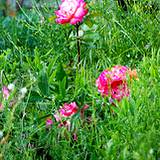|
Antique Roses
|
 |  |  |
Flavors depend on soil conditions, type of rose and color. The flavors are more pronounced in the darker roses. Flavors can range from tasting like strawberries, varies types of mint, spice or fruity. Antique roses always seem to outshine other roses in flavor. The older varieties such as Rosa rugosa and Rosa gallica, are considered the best for taste.
Besides being the most flavorful, antique and heirloom roses are usually the safest since most are grown in home gardens and need less care, like pesticides. Whatever you do, never eat roses bought from florists, nurseries, or garden centers.
Eating roses dates back to the ancient Romans. Roses grow best in rich, well-drained soil with full sun and good air circulation. These plants prefer regular pruning, watering, and fertilizing.
Rose sugar is very easy to make but takes some patience. All you have to do is take one-part petals with two-parts sugar and leave covered for a month. Then just strain and use for cookies, cakes, and sweet breads.
 |  |  |
Incredible Medicinal Rose Hips
Rose hips make a delicious tea that very high in vitamin C. Would you believe Rose hips actually have 4 times the vitamins than an orange? It's no wonder why ancient cultures used rose hips to treat colds, digestive disorders, stress, and urinary tract infections.
Walk into any health food store today and you'll find that rose hips are still a key ingredient in many herbal preparations. Sources of Vitamin C have long been staples in both the medicine chest and the diet. In World War II Victory Gardens, rose hips were grown so they could be converted into a Vitamin C-rich syrup to replace the oranges that could no longer be imported into Britain during war time.
For starters, check out Rosa rugosa 'Hansa' which sports double medium-red blooms and then lovely large red hips. R. moyesii 'Geranium' has brilliant geranium red single flowers with large, deep orange-red hips. R. 'Felicia' is a modern shrub rose in a pink blend and produces large, round hips that slowly turn from green to red. Hips start out hard and green, but the first frost usually turns them bright red or orange and helps to sweeten them. Leave them on the bush until they reach this stage and then collect them.
To prepare the hips for cooking, cut off both ends, cut in half lengthwise, remove the tiny hairs and seeds in the center and rinse. Don't use any aluminum pans or utensils because they will destroy the Vitamin C. Dry the washed hips on a cookie sheet in a low (250 degrees) oven and then store in a cool, dry spot or in the fridge in glass jars.
Rose Petal Jam
- ½ pound of red or pink edible rose petals (preferably from antique roses bush free of pesticides)
- 2 cups of sugar, divided
- 4 ½ cups of water
- juice of 2 lemons (about ½ cup)
Clip and discard the white base from all the antique rose petals.
Place the rinsed rose petals in a large bowl and sprinkle with sugar. Be sure to cover each petal with sugar. Let set overnight.
In a saucepan over low heat, place remaining sugar, water, and lemon juice; stirring to dissolve sugar. Stir in rose petals and let simmer 20 minutes. Increase heat medium-high and bring to a boil; continue boiling for approximately 5 minutes until mixture thickens and the temperature on a candy thermometer reaches 221 degrees F, or until a spoonful dropped onto a cold plate jells and holds its shape. After boiling, transfer the jam into hot sterilized jars. Fill them to within 1/4 inch of the top, wipe any spilled jam off the top, seat the lid and tighten the ring around them. Cover, label, and store in a cool place. Makes 1 pound of jam.
DISCLAIMER:
The statements made here have not been approved by the Food and Drug Administration. These statements are not intended to diagnose, treat or cure or prevent any disease. This notice is required by the Federal Food, Drug and Cosmetic Act.
Return from Antique Roses to Grandma's Incredible Edible Flowers
Return to Grandma's Wisdom Home





